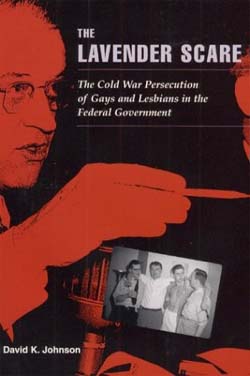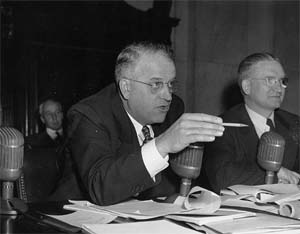
|
|
|
|
The Lavender Scare The Book Nook |
|
The Lavender Scare: The Cold War Persecution of Gays and Lesbians in the Federal Government by David K. Johnson; The University of Chicago Press; 277 pages; $30.00.
David K. Johnson, now Visiting Assistant Professor of History at the University of South Florida, has written an important work of gay scholarship that proves, once and for all, that the Lavender Scare was not a minor adjunct of the Red Scare, but a major government campaign in its own right. In fact, according to Dr. Johnson, "In 1950, many politicians, journalists, and citizens thought that homosexuals posed more of a threat to national security than Communists." The Lavender Scare, Johnson continues, "is the story of how Washington, D.C., and the federal bureaucracy - synonymous in the national imagination - came to be thought of as havens for socialists, misfits, and perverts. But it is also the story of the effect of the purges had on the local lesbian and gay population." Before the Lavender Scare, the nation's capital had a "vibrant lesbian and gay subculture," as thousands of men and women came from all over the USA to take advantage of the new jobs created by Franklin Delano Roosevelt's New Deal. In this golden age gay social life centered around Lafayette Park, "a center for gay cruising and socializing" located only a block away from the White House. According to Johnson, during the 1930s and 1940s "The neighborhood around Lafayette Park featured a number of rooming houses, restaurants, and cultural institutions that became centers of gay social life in the nation's capital." Alas, every sign of gay progress seems to bring in its wake a backlash; and "The crackdown on gay sociability in postwar Washington was a reaction to an earlier period of relative toleration and openness for homosexuals." Popular prejudice saw "lavender lads" everywhere: as "cookie pushers in striped pants" running the State Department or as part of a sinister "Homintern" that, like the red Comintern, sought world domination. The myth that queers ran rampant in Washington, D.C. was reinforced by Lieutenant Roy Blick of the District's vice squad, who told Congress "that the nation's capital was home to 5,000 homosexuals," of which "three-quarters of them - 3,750 - worked for the federal government." Jack Lait and Lee Mortimer, in their salacious 1951 exposť Washington Confidential, called the City "a garden of pansies." The Republican Party used the Lavender Scare to bring down the liberal Harry S. Truman administration. When Deputy Undersecretary of State John Peurifoy told Congress that "ninety-one homosexuals" were fired as "security risks," the GOP used the information to paint the Democratic White House both red and lavender. GOP Senator Kenneth Wherry (Nebraska) launched an investigation to determine "the infiltration of subversives and moral perverts into the executive branch of the United States Government." Wherry's Indiana colleague William E. Jenner went even further, calling the Roosevelt and Truman presidencies the "New Deal and Fair Deal and fairy deal administrations." When Lester C. Hunt, Jr. was arrested in Lafayette Park, the GOP tried to blackmail his father, Senator Lester Hunt (D-Wyoming), out of running for re-election (1954). The venerable statesman was so distraught by this smear campaign that he killed himself; an incident that was fictionalized by Allen Drury in his 1959 novel Advise and Consent. When the Republican Dwight Eisenhower took office in 1953, one of the first things he did was to issue Executive Order 10450, which ordered immediate dismissal of federal workers for "any behavior which suggests the individual is not reliable or trustworthy," including "sexual perversion." Though Dr. Johnson admits that "The total number of men and women affected by the anti-homosexual purge is incalculable," he estimates that "as many as five thousand suspected gay or lesbian employees may have lost their jobs with the federal government during the early days of the Cold War. At the very least, these partial statistics suggest that the total number of federal employees fired for homosexuality is well into the thousands."
Though it was the worst of time, many lesbian women and gay men continued to call Washington, D.C. home; abandoning Lafayette Park but gathering in new venues like the Chicken Hut. The Mattachine Society of Washington was formed in 1956; and heroes like Franklin Kameny, Bruce Scott and Clifford Norton dared to challenge the system. Finally, in the landmark case of Norton v. Macy (1969), the U.S. Court of Appeals "ruled that federal civil servants could no longer be fired solely on the grounds that they were homosexual." Thus the Lavender Scare ended with a whimper, at least for civilians. (It continues in the military.) The Lavender Scare is more than a great work of history. It is a cautionary tale, told at a time when the Republican Bush Administration is busy curtailing civil liberties and reviving the Lavender Scare as a wedge issue. The nephews and nieces of the "lavender lads" (and lasses) who once "threatened" the Republic by working for the State Department are now getting married; but the backlash is the same. Washington D.C. once again has a dynamic GLBT community. Let's keep it that way. What's Your Favorite Book? "Robert A. Heinlein's Stranger in a Strange Land [1961] has always been my favorite novel," writes Bruce Hogman. "It has something for everyone who enjoys science fiction and action thrillers, being not so much science fiction as social fiction and the logical outcome from preposterous beginnings. In Stranger, there's a hero with stout friends, love interest, an honest lawyer in the Perry Mason mold, a lot of self-serving government types and a few good men. It stands the test of time." If you have a favorite book, e-mail the title and the author; a sentence or two explaining why you like that book so much; and a name that can be used in print to jessemonteagudo@aol.com. Subject: "Book Nook Favorite Book."
|
 The Cold War persecution of gays and lesbians in the federal government is an important chapter in our American history. Though historians from Jonathan Ned Katz to John D'Emilio have dealt with the topic, we had to wait half a century after the events for a major work of history to put it into perspective.
The Cold War persecution of gays and lesbians in the federal government is an important chapter in our American history. Though historians from Jonathan Ned Katz to John D'Emilio have dealt with the topic, we had to wait half a century after the events for a major work of history to put it into perspective.
 U.S. Senator Kenneth Wherry (R-Nebraska) vigorously pursued the campaign McCarthy helped unleash against gay men and lesbians in the federal government.
U.S. Senator Kenneth Wherry (R-Nebraska) vigorously pursued the campaign McCarthy helped unleash against gay men and lesbians in the federal government.  Jesse Monteagudo is a free-lance writer and gay activist who lives in South Florida with his life partner of 19 years. His e-mail address is
Jesse Monteagudo is a free-lance writer and gay activist who lives in South Florida with his life partner of 19 years. His e-mail address is